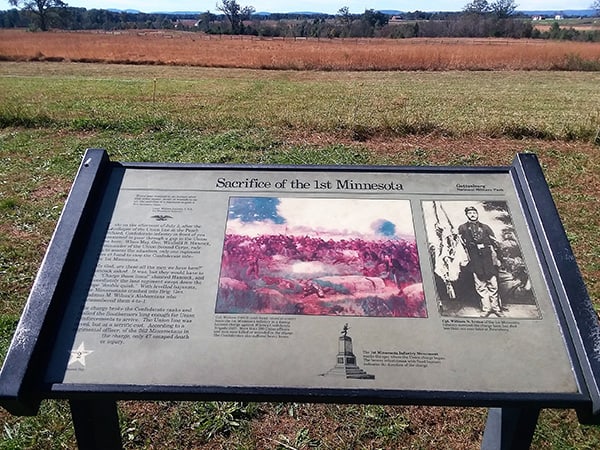 On our way to Carlisle to be a part of the Celebrate the Book Week, my wife and I stopped at Gettysburg, our first visit to this landmark in a terrible war. Here I am at the monument erected to the 1st Minnesota Volunteer Infantry Regiment.
On our way to Carlisle to be a part of the Celebrate the Book Week, my wife and I stopped at Gettysburg, our first visit to this landmark in a terrible war. Here I am at the monument erected to the 1st Minnesota Volunteer Infantry Regiment.
In the great battle fought at Gettysburg, the 1st Minnesota—or the 262 still left of the regiment—were ordered to plug a breach in the Union line on Cemetery Ridge, which, if left open, would have allowed the Confederate forces to take that high ground so essential to the outcome of the battle. Outnumbered at least 5 to 1, the 1st Minnesota fixed bayonets and plunged without hesitation into the breach. They’d been asked to hold the enemy back for five minutes, time enough to allow reinforcements to be brought up. They held the host of Confederates at bay for fifteen minutes, but at the cost of more than 80% of their regiment. Their sacrifice made it possible for the Union to hold the high ground, the struggle for which would end the next day with the fateful Pickett’s Charge.
In the commemoration of the sacrifice by the men of the 1st Minnesota, President Calvin Coolidge later said, “Colonel Colvill and those eight companies of the First Minnesota are entitled to rank as the saviors of their country.”
Standing on that ground, site of unimaginable bloodshed, I felt two competing emotions. On the one hand, a terrible sense of the slaughter of war; on the other, a great admiration for the courage of the men on both sides of this conflict. And then a third emotion: An abiding sadness for those loved ones, those thousands and thousands left to grieve.
We are a nation whose history is written in blood. I pray long and hard that someday we learn a different response to conflict, that words replace bullets, that understanding replaces enmity. A dream, maybe, but if we don’t dare to dream, will the world ever change?


Thank you for this posting about the First Minnesota Volunteers. My second great uncle, Martin Maginnis, survived the battle of Gettysburg, although I don’t know how he participated. He enlisted in the 1st Minnesota Volunteers in 1861, leaving Hamline College in Red Wing, and worked his way up from private to major. His parents were Irish immigrants (though from Liverpool) who settled as farmers in Goodhue county in the 1850’s. After the war he went westward to Montana where he was the first Congressman from what was then Montana territory. One of his brothers, Charles Patrick Maginnis, became the sheriff of Stevens county then was in charge of the federal land office in Duluth. Basically alll the male members of the family moved on to Portland OR around 1905, and I was born in Oregon. I preceded your foreshortened student days at Stanford (AB 61,MD in 64). Yes, I read your biography! Things were a lot quieter in 56-64.
I have read all your Cork O’Connor books up to Thunder Bay and am hoping to continue the series!